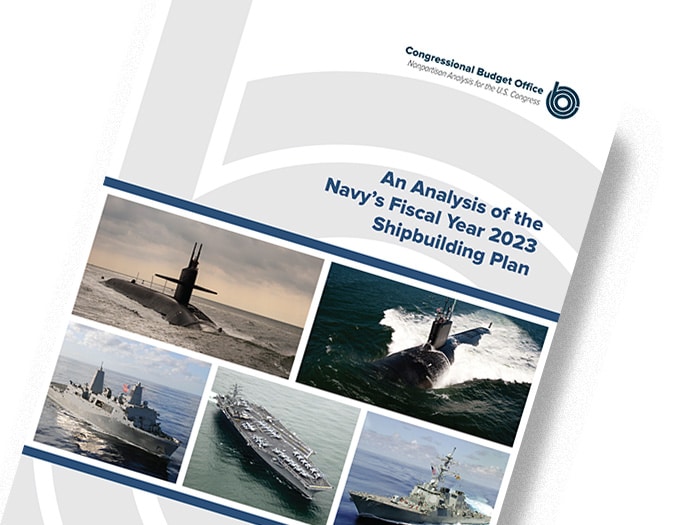
CBO: Navy shipbuilding plan has a hefty price tag
Written by Nick Blenkey
Expect naval shipbuilding analysts to have a busy weekend poring over a just-released report from the nonpartisan Congressional Budget Office (CBO). Among its findings are that even if the Navy received the same amount of funding (in constant dollars) for shipbuilding in each year from 2023 to 2052 that it has received in each of the past five years—a half-decade that saw the highest level of such funding since the 1980s—the service still could not afford any of the three alternatives in its 2023 shipbuilding plan.
Each year the Department of Defense submits a congressionally-mandated report with the President’s budget describing the Navy’s planned inventory, purchases, deliveries, and retirements of ships in its fleet for the next 30 years. This year, in a departure from all previous shipbuilding plans, the Navy’s fiscal year 2023 shipbuilding plan provided three alternative long-range projections of its future fleet rather than one.
The just-released Congressional Budget Office report analyzes the alternatives in the 2023 plan and estimates the costs of implementing each of them.
Here’s the CBO’s bare-bones summary of its report:
COST
The three alternatives in the Navy’s 2023 plan would require average annual shipbuilding appropriations that were 23 % to 35 % more than the average over the past five years. CBO estimates that total shipbuilding costs would average about $30 billion to $33 billion (in 2022 dollars) over the next 30 years, which is 14% to 18% more than the Navy estimates. The Navy’s total budget would increase from $220 billion today to roughly $290 billion (in 2022 dollars) in 2052.
PURCHASING PLAN
The Navy would purchase 282 battle force ships under Alternative 1, 294 under Alternative 2, or 340 under Alternative 3. (Battle force ships include aircraft carriers, submarines, surface combatants, amphibious warfare ships, combat logistics ships, and some support ships.) Overall, Alternative 1 places slightly more emphasis on buying large surface combatants than Alternative 2 does. Under Alternative 2, the Navy would buy more submarines than under the other alternatives, although it would purchase more existing classes of submarines and fewer next-generation submarines. Under Alternative 3, the Navy would buy more ships of all types, except for submarines, than under the other alternatives. (The 2023 plan offers few details about the costs or quantities of unmanned surface or undersea vessels.)
FLEET SIZE
If the Navy adhered to the schedule for purchases and ship retirements outlined in its 2023 plan, by 2052 the number of battle force ships would increase from 292 today to 316 under Alternative 1, 327 under Alternative 2, or 367 under Alternative 3. In all three cases, the fleet would be smaller over the next 10 years than it is today, before increasing in size.
FLEET CAPABILITIES
Under all three alternatives, the Navy would reduce the fleet’s firepower over the next decade but would eventually expand its missile capability by increasing the number of missile cells (which are vertical tubes or launchers on surface ships and submarines that carry the Navy’s offensive and defensive missiles) and deploying them on more ships than they are deployed on today.




